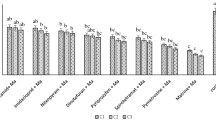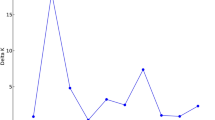Abstract
MOEREKE yellow trays are a simple and cheap method of trapping aphids, and are being widely used for the study of aphid flight and behaviour. These traps, however, have never been standardized with respect to their differential catch of various species. Three yellow trays and a suction trap were operated close to each other, over a small plot of pyrethrum not infested with aphids, for more than two years at the East African Agriculture and Forestry Research Organization, near Kikuyu, Kenya. There are reasons for thinking that the suction trap takes a fairly accurate sample of aphid density. The ratio of yellow-tray to suction-trap catch for the commoner species is shown in Table 1. The total number of specimens, from both traps, is placed in parentheses. All the specimens listed were alate viviparous females except for the male Rhopalosiphum maidis.
This is a preview of subscription content, access via your institution
Access options
Subscribe to this journal
Receive 51 print issues and online access
$199.00 per year
only $3.90 per issue
Buy this article
- Purchase on SpringerLink
- Instant access to full article PDF
Prices may be subject to local taxes which are calculated during checkout
Similar content being viewed by others
Author information
Authors and Affiliations
Rights and permissions
About this article
Cite this article
EASTOP, V. Selection of Aphid Species by Different Kinds of Insect Traps. Nature 176, 936 (1955). https://doi.org/10.1038/176936b0
Issue date:
DOI: https://doi.org/10.1038/176936b0
This article is cited by
-
The role of visual and olfactory plant cues in aphid behaviour and the development of non-persistent virus management strategies
Arthropod-Plant Interactions (2017)
-
10.1007/BF00297083
CrossRef Listing of Deleted DOIs (2011)
-
10.1007/BF00302539
CrossRef Listing of Deleted DOIs (2011)
-
Occurrence of aphid vector and genetic tolerance to infection by potyvirus in hot pepper
Euphytica (2010)
-
Visual ecology of aphids—a critical review on the role of colours in host finding
Arthropod-Plant Interactions (2007)



